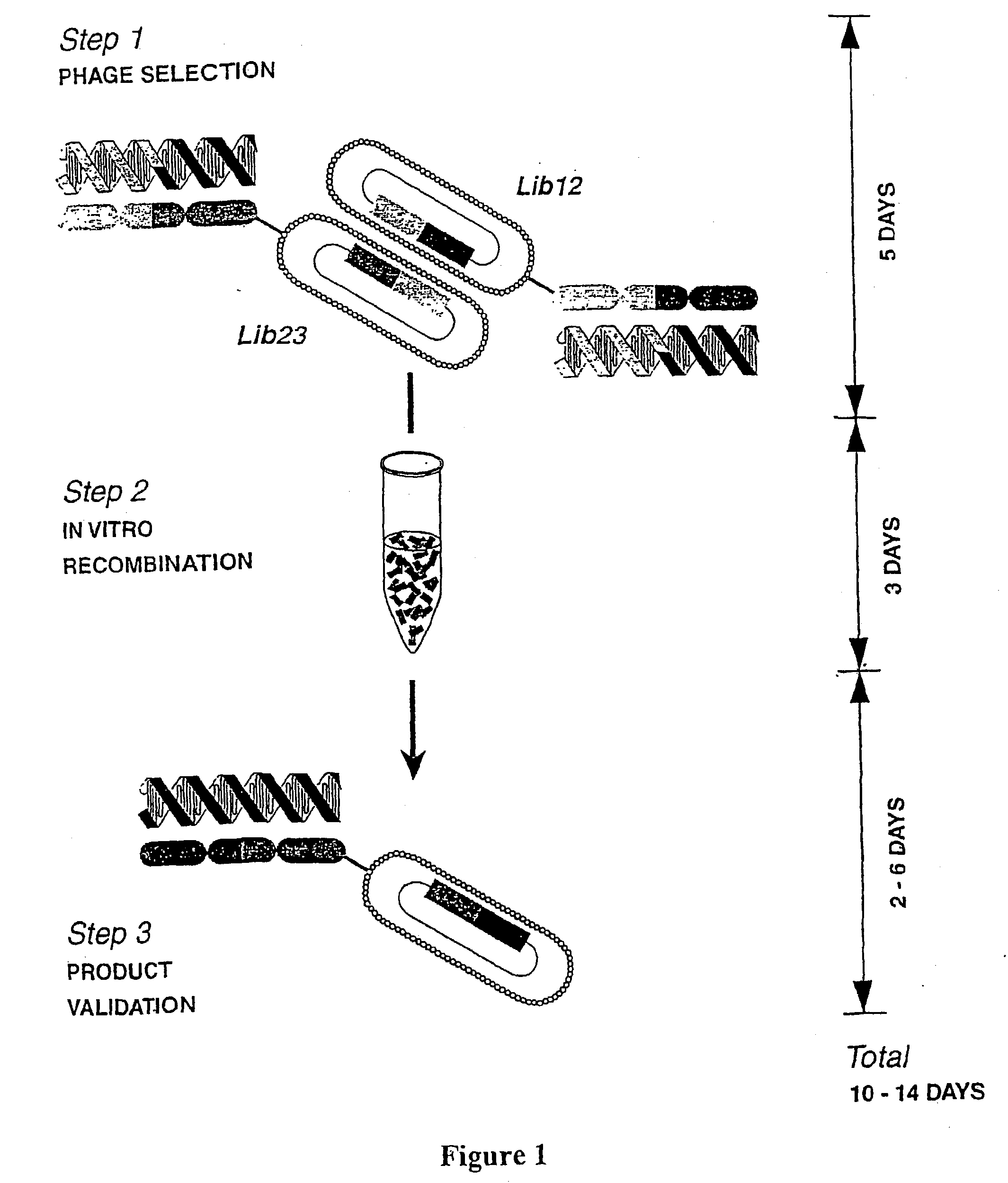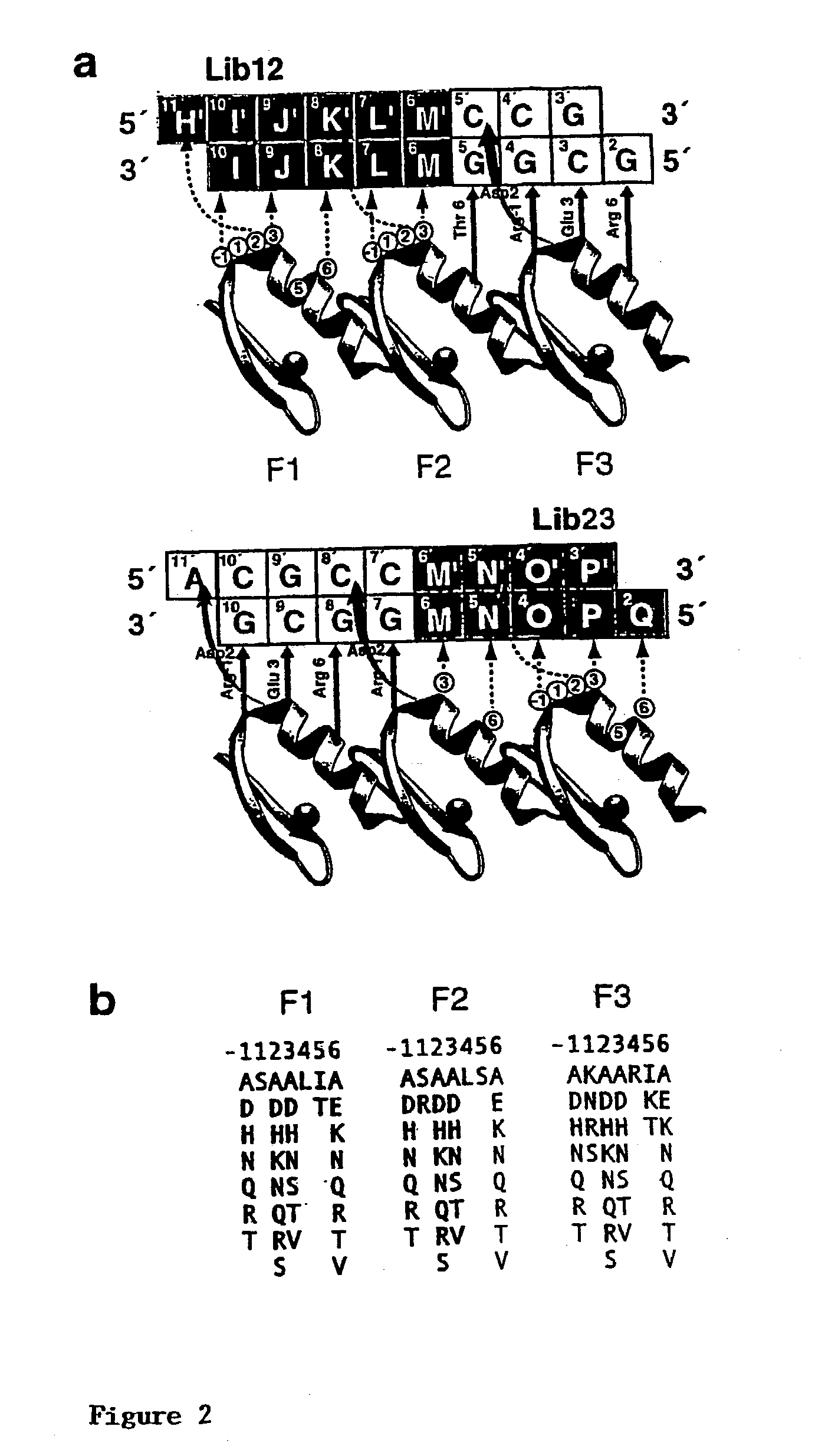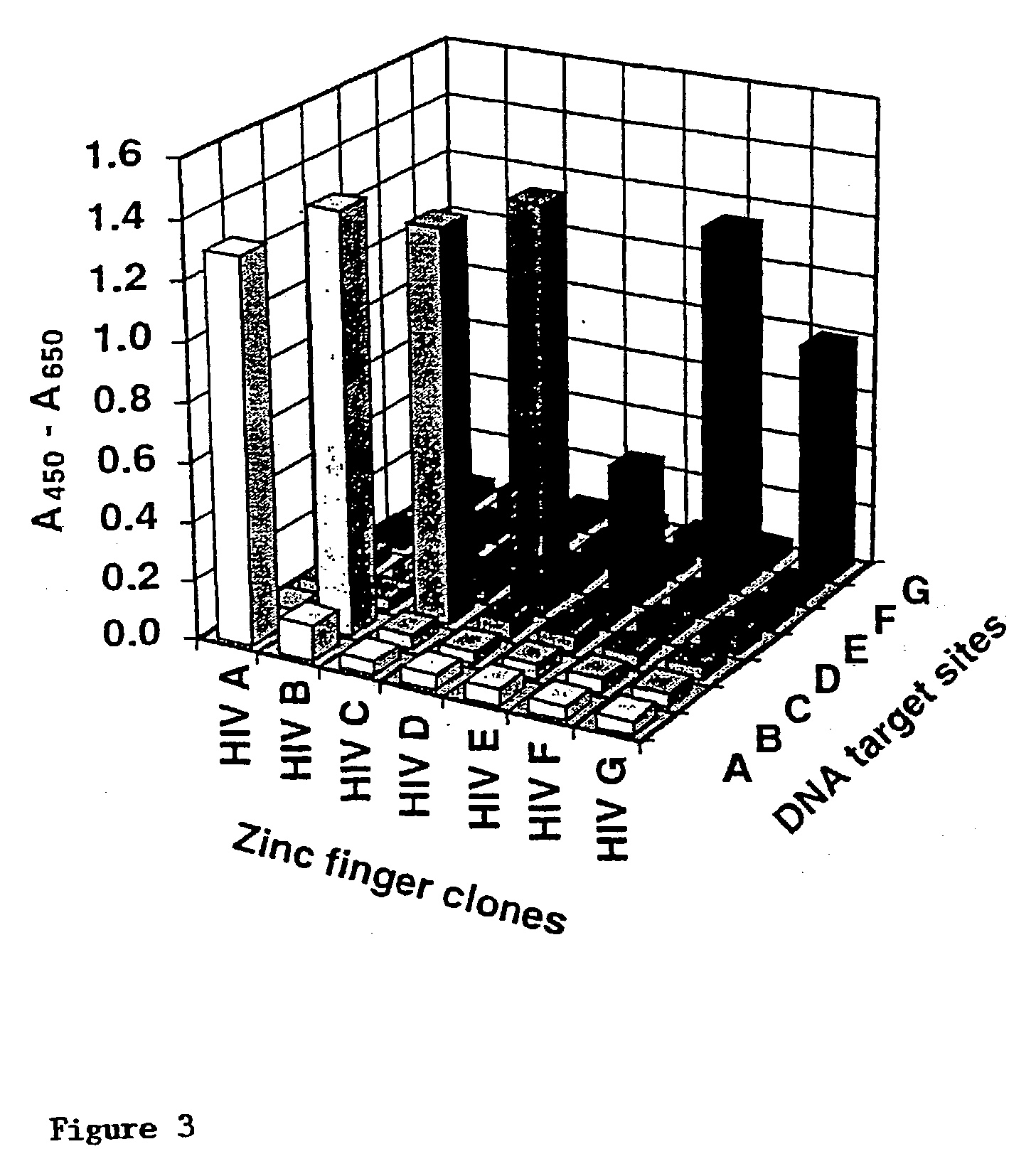Modulation of viral gene expression by engineered zinc finger proteins
a technology of engineered zinc finger proteins and gene expression, applied in the direction of biochemistry apparatus and processes, animals/human peptides, enzymes, etc., can solve the problems of limited implementation of this strategy, limited general applicability of both methods, and limited application of both methods
- Summary
- Abstract
- Description
- Claims
- Application Information
AI Technical Summary
Benefits of technology
Problems solved by technology
Method used
Image
Examples
example 1
Construction of Phage Display Libraries for Selection of DNA-Binding Domains
[0263] Zinc fingers capable of binding HIV nucleotide sequences are constructed using a `bipartite-complementary` system as described above and illustrated in FIG. 1. This system comprises two master libraries, Lib12 and Lib23, each of which encodes variants of a three-finger DNA-binding domain based on that of the transcription factor Zif268 (6, 19), which are complementary as Lib12 contains randomisations in all the base-contacting positions of F1 and certain base-contacting positions of F2, while Lib23 contains randomisations in the remaining base-contacting positions of F2 and all the base-contacting positions of F3 (FIG. 2a). The non-randomised DNA-contacting residues carry the nucleotide specificity of the parental Zif268 DNA-binding domain.
[0264] The libraries are constructed by known techniques, briefly described here.
[0265] Gene inserts for phage libraries are constructed by end-to-end ligation of s...
example 2
Production of DNA-Binding Domains that Target the HIV-1 Promoter
[0272] Phage selections from the two master libraries described in Example 1 (Lib12 and Lib23) are performed using the generic DNA sequence 3'-HIJKLMGGCG-5' for Lib12, and 3'-GCGGMNOPQ-5' for Lib23, where the underlined bases are bound by the wild-type portion of the DNA-binding domain and each of the other letters represents any given nucleotide (FIG. 2a). A number of sites in the well-characterised promoter of HIV-1 are targeted.
[0273] In this example, the two zinc finger libraries (Lib12 and Lib23) are subjected to selection in parallel, the nucleotide sequences used (ie. HIJKL / MNOPQ) being from HIV-1 between positions -80 and +60 (see Table 1 / FIG. 3).
[0274] Tetracycline resistant bacterial colonies are transferred to 2.times.TY liquid medium (16 g / litre Bactotryptone, 10 g / litre Bactoyeast extract, 5 g / litre NaCl) containing 50 .mu.M ZnCl.sub.2 and 15 .mu.g / ml tetracycline, and cultured overnight at 30.degree. C. in...
example 3
Sequences and Properties of Isolated Three Finger Constructs
[0288] Using the above protocol, eight DNA-binding domains are produced (Table 1, Clones HIV-A to HIV-G and HIV-A' (also known as Clone HIV-H; binds 5'-GCC TGG G(T / C)G-3').
12TABLE 1 Selection of DNA-binding domains to recognise the HIV-1 pro-moter. Table 1 Legend: DNA target Zinc finger sequence (a) sequence (b) Clone F1 F2 F3 F1 F2 F3 Kd / nM (c) 3'-H IJK LMN QPQ -5' -1123456 -1123456 -1123456 HIV-A T GCG GAG GGA RSDELTR RSDNLST RRDHRTT 1.2 .+-. 0.2 HIV-A' G GCG GGT CCG RSDVLTR RSDHLTT DYSVRKR 4.9 .+-. 0.4 HIV-B G AGG GGT CAG DSAHLTR RSDHLST DSANRTK 1.0 .+-. 0.1 HIV-C T ACG TCG TAG ASADLTR NRSDLSR TSSNRKK 13.7 .+-. 3.6 HIV-D T TCG TCG ACG HSSDLTR QSSDLSK QNATRKR 4.0 .+-. 0.6 HIV-E T CCG AGT CAT DSSSLTK QSAHLST DSSSRTK 36.6 .+-. 15.0 HIV-F T CTC TCG AGG ASDDLTQ RSSDLSR QSAHRTK 13.3 .+-. 4.8 HIV-G G GAT CAA TCG RSDALIQ DRANLST ASSTRTK 40.3 .+-. 14.6
[0289] (a) Nucleotide sequences from the HIV-1 promoter of the form 3'-HIJKLMNO...
PUM
| Property | Measurement | Unit |
|---|---|---|
| Force | aaaaa | aaaaa |
| Current | aaaaa | aaaaa |
| Current | aaaaa | aaaaa |
Abstract
Description
Claims
Application Information
 Login to View More
Login to View More - R&D
- Intellectual Property
- Life Sciences
- Materials
- Tech Scout
- Unparalleled Data Quality
- Higher Quality Content
- 60% Fewer Hallucinations
Browse by: Latest US Patents, China's latest patents, Technical Efficacy Thesaurus, Application Domain, Technology Topic, Popular Technical Reports.
© 2025 PatSnap. All rights reserved.Legal|Privacy policy|Modern Slavery Act Transparency Statement|Sitemap|About US| Contact US: help@patsnap.com



